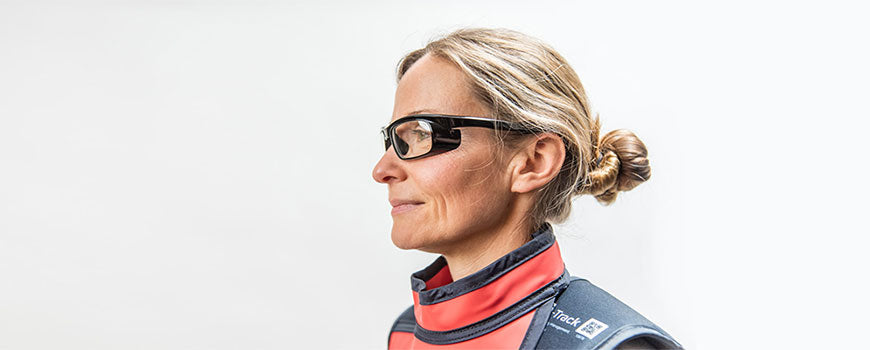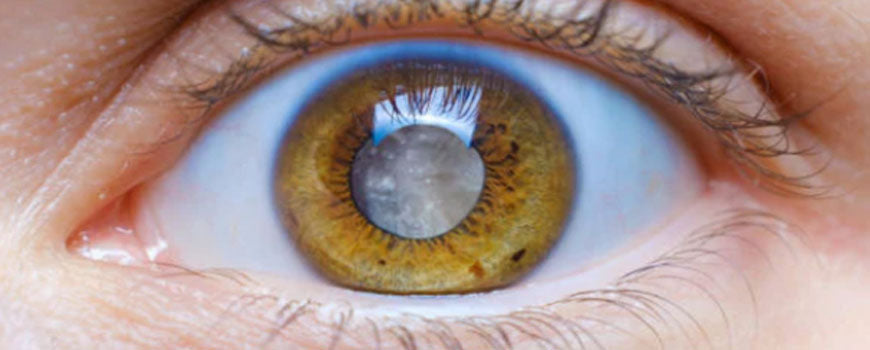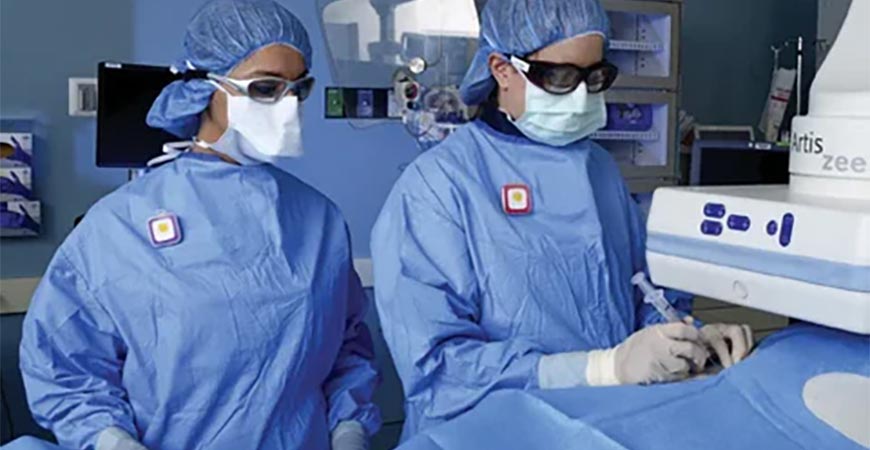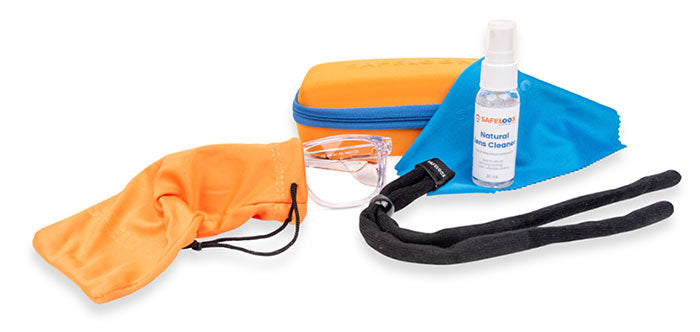Radiation protection is serious business, especially when it comes to safeguarding your eyes during medical imaging procedures. That's where leaded eyewear comes in, providing a shield against harmful ionising radiation.
X-ray radiation might seem invisible, but it's not invincible – it can pose serious health risks to medical staff. So why are we still dragging our feet when it comes to protecting those on the front lines? Research shows that lead glasses, a crucial piece of PPE radiation eyewear, are often missing in action during Image Guided Interventional Procedures (IGIPs). Despite official recommendations by the ICRP, nurses and other staff are left to fend for themselves against harmful radiation exposure. It's time to step up and prioritise the standardisation and mandate of lead glasses for all medical staff working in medical imaging environment. Until then, each medical professional must take charge of their own protection during every radiation exposure.
This post covers the importance of lead glasses and why they should be seen as an essential part of every medical professional's PPE. It also covers how to choose the right lead glasses, use them properly, and maintain them effectively to ensure optimal daily protection.
I. The Basics of Lead Glasses
A. What are Lead Glasses?
Lead glasses are essential radiation safety equipment in a wide range of medical settings. These specialised safety glasses protect the eyes from the damaging effects of ionising radiation and scatter radiation, such as X-rays and gamma rays.

Lead glasses have many names in the medical industry, including:
- X-Ray glasses
- Radiation glasses
- Leaded eyewear
- Radiation eyewear
- Radiation safety glasses
- Radiation protection glasses
B. What are the Radiation Protection Features of Lead Glasses?
Leaded lenses
Radiation eyewear features lead-oxide infused lenses that absorb and block the majority of radiation in order to protect the eyes.
Leaded side shields
Lead glasses styles may feature leaded side shields that provide lateral protection against scatter radiation which is radiation that reflects off surfaces and objects in the room, so it can come at you from any direction. To reduce the dangerous impact of scattered radiation, it is highly recommend that you invest in lead glasses that are equipped with leaded side shields.
II. The Harmful Effects of Radiation Exposure to the Eye
The eye's lens is among the most radiosensitive tissues in the human body (1). Protective lead aprons are mandatory and often facility-supplied for all persons working with and around devices that produce ionising radiation. Yet, despite the increased risks to the eye, lead safety glasses are seldom available, especially for 'secondary' candidates like nurses and technicians.
For nurses, doctors and other healthcare professionals and staff who suffer repeated daily exposure to ionising radiation (Gamma, high-energy Beta, or X-rays), there may be no pain or real damage associated with any given low-dose exposure. Yet, without appropriate protection in the form of leaded safety eyewear, the effects will compound over time - with damaging results.
The so-called late (or compounding) tissue reactions associated with occupational radiation exposure have been widely studied and linked to the prevalence of vision-impairing posterior sub-capsular opacities and cataracts, as well as other ocular diseases, such as glaucoma and macular degeneration.
The biggest health concern is the development of cataracts, which are usually a result of long-term exposure to low-dose radiation. Cataracts are a clouding of the eye's natural lens and can cause vision loss and blindness if left untreated. Additionally, other eye injuries that can occur include cornea damage, retinal damage, and radiation-induced tumours.
For further reading, refer to the Australian Radiation Protection and Nuclear Safety Agency (ARPANSA) website: Health effects of ionising radiation

III. Reduced Radiation Dose Limit to the Lens of the Eye
In April 2011, the International Commission on Radiology Protection (ICRP) released an official communication entitled ‘Statement on Tissue Reactions’.
This report pointed to new and unsettling epidemiological evidence relating to the tissue reaction effects of occupational radiation doses to the lens of the human eye.
Since this crucial new evidence was released:
The Commission now recommends an equivalent dose limit for the lens of the eye of 20 mSv in a year, averaged over defined periods of 5 years, with no single year exceeding 50 mSv.
Based on this new evidence, the ICRP presented a revised threshold value of 0.5 Gy for dangerous tissue reactions to the lens of the eye. This marks a tenfold reduction compared to the previous value of 5 Gy given by the ICRP.
What this means is that the new maximum allowed dose could reasonably be reached across the working life of most members of Australia’s medical workforce, many of whom are exposed to radiation on an almost daily basis.
Despite official recommendations, PPE radiation eyewear is still rarely mandated or made available for nurses and other staff in an Image Guided Interventional Procedure (IGIP) setting. Therefore, it falls to each medical professional to ‘first do no harm’ by protecting themselves during every exposure.
Consider this extract from the ARPANSA website:
The nature of IGIP is that if no additional protective measures for the eyes are applied, personnel with a typical workload may receive doses to the lens of the eye that would greatly exceed the new dose limit, and over time could result in lens opacities. (3)
View/download the related ARPANSA fact sheet.
IV. Who is at Risk of Radiation-Induced Eye Lens Injury?
In healthcare, ionising radiation is released by devices and equipment applied in a wide range of diagnostic and interventional procedures, including:
- Interventional Radiology
- Interventional Cardiology
- Angiography
- Fluoroscopy
- Cardiac Electrophysiology (EP)
- Vascular Surgery

The risk of posterior sub-capsular opacities and cataracts is not limited to cardiologists, radiologists and other specialists assumed to be ‘primary’ exposure candidates alone. In fact, any and all personnel, technicians, nurses and doctors present in the room while radiology equipment is active are candidates for risk.
What’s more, statistics are quite staggering with, for example, one comprehensive review showing that as many as 50% of cardiologists and IR personnel were classified with posterior lens opacities through a vast cross section of targeted studies. (2)
- Radiologists and Radiologic Technologists
- Physicians in the areas of Pneumology, Anaesthesiology, Urology, Endoscopy, Pain Management, Surgeons and Orthopaedics, Interventional Neurologists and other Interventional Specialists
- Nurses and Technicians working around x-ray devices
- Paramedics who assist during procedures
- Dental Workers
To minimise the risk of eye lens damage, proper protective glasses and operational procedures must be implemented, especially for those performing long diagnostic imaging procedures.
V. Choosing the Right Lead Glasses
When choosing lead glasses, it is important to consider the lead equivalent, the style of the glasses as well as how well they fit your face to ensure optimal protection and comfort.
A. Types of lead glasses - choose for protection
Three factors influence the level of protection provided by a pair of leaded safety goggles:
1. Lead equivalence - the thickness of the lead-oxide infused lenses.
Lead equivalence measures the amount of lead in the glasses and/or their side-shield material. The higher the lead equivalence, the greater the protection provided. It is measured in "mm Pb", e.g. 0.75 mm Pb.
2. The presence of side shields
The level of safety also depends on whether the frames include side protection. Lead protection eyewear frames come in different styles to suit different face shapes and special occupational requirements.

3. Frame style (whether they are form-fitting and whether or not they come with side shields)
There are three kinds of lead glasses that provide different levels of protection.
| Wraparound Lead Glasses | Semi-Wraparound Lead Glasses | Flat Lead Glasses |
|---|---|---|
| This type offers ‘wraparound’ protection at the front and around the side of the eye. Depending on the curve of these frames, they do usually not require additional side shield protection. | This kind of frame provides front protection and some side protection (‘semi-wraparound’). It is usually recommended to add leaded side shields for additional lateral protection. | This frame is ideal for many prescription types and scripts. However, they only provide front protection. If you choose a flat leaded glasses frame, ensure they feature side shields where leaded side shields can be attached to offer wraparound protection for your eyes. |
| Provides limited choices for prescription leaded lenses due to the wraparound curve. | Suitable for most prescription leaded lenses | Ideal for all prescription leaded lenses. |
 |
 |
 |
Always check with the manufacturer or distributor if leaded side shields can be added to the frame styles, especially semi-wraparound and flat front leaded lens of glasses, to provide additional protection against scatter radiation during diagnostic imaging procedures.
B. The weight and size of lead glasses - choose for comfort
Weight - How heavy are lead glasses?
Lead infused radiation safety lenses are heavier than average optical or safety lenses. Prescription lead safety glasses are heavier still - more so if you have a strong prescription or bifocal or progressive lenses.
Lead glasses can weigh anywhere from 60 grams, for small non-prescription frames, to 120 grams, for large frames such as fitover prescription glasses.
We’re not saying that you should sacrifice lead equivalence or your prescription for a comfortable weight, but be mindful that the frames you choose don’t feature excessive or unnecessary areas of lens which could make the radiation goggles uncomfortably heavy to wear.
Read more on how to choose the right prescription lead glasses.
Size - Do the lead glasses fit your face?
A great way to ensure that you choose the right sized frames for your face is to compare the listed dimensions, such as width, bridge size, length of temple arms, and lens width and and height, with a pair of your own prescription spectacles or form-fitting sunglasses.
It’s important to remember that, to provide adequate protection, there should be no gaps or openings through which radiation can penetrate, as would be the case with frames that are either too big or too small.
C. Avoid the top 4 mistakes when purchasing lead glasses
1 - Purchasing prescription lead glasses before a prescription revision
Since radiation safety glasses can last up to five years, we recommend that you visit your optician to revise your prescription shortly before you order your lead glasses. Optical prescriptions are usually revised every two to three years, but in the case of improving or worsening eye conditions, they can change as often as once a year.
To save money and get the most out of your purchase, you should never pay to order lead glasses with an outdated prescription.
2 - Choosing progressive and bifocal lenses with standard segment heights
Segment height refers to the vertical distance from the bottom of your lens to the bifocal line, the progressive edge, or your pupil.

This segment height is unique to the individual, and what a lot of people don't know, the chosen lead glasses frame. Many companies just apply the standard segment height when you order bifocal or progressive prescription lead glasses, resulting in a compromised vision.
The only way to ensure that you see clearly through bifocal or progressive vision leaded lenses is to take the chosen frame to your optometrist who will measure segment height that's unique to your face and the selected frame.
3 - Purchasing radiation safety glasses without first trying them on
As lead glasses can be heavy to wear and and be pricey, you want to ensure you have invested in the right pair of lead glasses that you will wear to protect your eyes from radiation. The only way to find out is asking companies for a product trial to confirm the selected lead glasses are comfortable to wear and fit you properly. Deutsch Medical's safety eyewear brand Safeloox offer medical professionals fitting experiences in-person, virtually or at home over a period of 7 days.

Due to the importance of adequate protection, fit and comfort in an occupational medical setting, we always recommend that you try your lead safety frames on in-person, at home, or via a virtual try-on option.
4 - Purchasing radiation glasses without a protective case and strap
Proper use and care of lead glasses is crucial for radiation risk reduction. The glasses should be worn with an adjustable strap that keeps them safely in place during all imaging procedures.
What’s more, since radiation safety frames are unique in their size, shape and proportions, it’s important that your purchase includes a purpose-made hard case that won’t damage your frames or scratch your lenses.

VI. What are the Radiation Safety Standards for Lead Glasses?
IEC International Standards
The International Electrotechnical Commission, based in Switzerland (IEC) is a global organisation that defines and publishes international standards for all electrical, electronic and medical technologies.
The IEC 61331 Part 3 standard specifies the requirements for radiation protective equipment, including leaded eyewear, and defines lead equivalence as the thickness of lead that provides the same level of attenuation as the material being measured.
The lead equivalence requirements for leaded eyewear in the IEC 61331 Part 3 standard are as follows:
-
For lenses with a thickness of less than 2 mm, the lead equivalence should be at least 0.35 mm Pb.
-
For lenses with a thickness of 2 mm or more, the lead equivalence should be at least 0.5 mm Pb. However, most companies now offer 0.75mm Pb leaded lenses.
These lead equivalence requirements ensure that the leaded eyewear provides sufficient protection against primary and scatter radiation during medical procedures, such as fluoroscopy or radiography.
You can buy the IEC Standard PDF or learn more.
ARPANSA - Australian Radiation Protection Standard
Every medical institution follows different policies or guidelines, which can become confusing.
In Australia, the Australian Radiation Protection and Nuclear Safety Agency (ARPANSA) recommends that radiation protection clothing conforms with the AU/NZS 4543.3-2000, based on the international standard IEC 61331-3:1998, mentioned above.
For further information on AU/NZS 4543.3-2000, see the ARPANSA Fact Sheet, in which the agency offers several recommendations on improving Eye Safety in Image Guided Interventional Procedures (IGIP).
VII. Proper Use and Care of Lead Glasses
Don't let radiation sneak up on you – take care of your lead glasses like they're your superhero shield! Proper use and maintenance are key to minimising your risk of exposure during diagnostic imaging procedures. Remember to wear your glasses at all times, and handle and store them with care to prevent contamination or damage. Keep them clean and inspect them often to make sure they're still up to the challenge of protecting you properly from radiation.
A. Instructions for properly wearing and storing lead glasses
Radiation glasses should be worn at all times during X-Ray procedures, and they should be handled and stored in a way that minimises the risk of contamination or damage. Essential tips include:
Wearing
- Don’t wear lead glasses on top of your head or you might stretch the frames.
- Don’t push on the nose piece as this could distort it.
- Remove and put your lead glasses on with both hands or you’ll bend the frame.
- For frequent removal, fit lead glasses with a retainer chord.
Storage
- Always store lead glasses in their correct case when not in use.
- Always store lead glasses in their hard case with the lenses facing forward.
- Store your glasses in a cool area as heat could warp the frame.
- Avoid placing your lead glasses where they might be splashed with corrosive liquids, such as near a sink or vanity stand.
B. Understanding when lead glasses should be replaced
Last but not least, lead radiation protection glasses tend to last a maximum of five years, but they will not last forever - particularly with daily use!
Regular inspection is necessary to ensure the glasses continue to provide adequate protection, as chips, scratches and damage could create weaknesses that result in less than optimal protection over time.
You will also need to replace your prescription lead glasses when your prescription becomes outdated, which is why it’s so important to update your prescription before you order a custom pair of lenses.
Likewise, as the form of your face changes with age, exercise and diet, you may need to update your frames to ensure that your lead glasses still fit snugly and safely.
In Conclusion
The harmful effects of radiation exposure often take years to appear, resulting in conditions that may cause vision impairment or blindness over time. Delayed onset makes it hard to identify the harm until it's too late - which is why protective lead safety glasses are so essential.
To minimise the risk of eye lens damage, proper protective glasses and operational procedures must be implemented, especially for those performing long or regular diagnostic imaging procedures.
This starts with choosing the right lead glasses, after which it is essential that you:
- Engage in correct wearing and storage practices.
- Maintain the fit and condition of your lead glasses with regular inspection, cleaning and maintenance.
- Replace your lead glasses at least every five years.
Once you, as a nurse, doctor or healthcare practitioner, understand the dangers of regular occupational exposure to ionising radiation, you can see why opting for the highest possible protection is so important.
To comply with the latest national and international safety standards, we recommend lead glasses with a 0.75mm Pb and leaded side shields with 0.50mm Pb, combined with a selection of coatings and features to suit your facial form and unique occupational process.
Sources:
- Hamada, N., Azizova, T. V., & Little, M. P. (2020). An update on effects of ionizing radiation exposure on the eye. The British journal of radiology, 93(1115), 20190829. https://doi.org/10.1259/bjr.20190829
- Della Vecchia, E., Modenese, A., Loney, T., Muscatello, M., Silva Paulo, M., Rossi, G., & Gobba, F. (2020). Risk of cataract in health care workers exposed to ionizing radiation: a systematic review. La Medicina del lavoro, 111(4), 269–284. https://doi.org/10.23749/mdl.v111i4.9045
- ARPANSA (2020). Radiation Protection Series C-1 (Rev. 1). Code for Radiation Protection in Planned Exposure Situations.

